Gangtok - Hills that praise patriotism and magnificence.
Gangtok India
Capital of Sikkim, literal meaning of Gangtok is “The High Hill.” It is a Charming Hill station perched on a ridge at a height of 1650 m above the sea level. The tall and honorable snow covered peaks of Kanchenjunga roosting to a height of 8598 m form a majestic backdrop to this beautiful capital of Sikkim.[caption id="attachment_3401" align="aligncenter" width="600"]
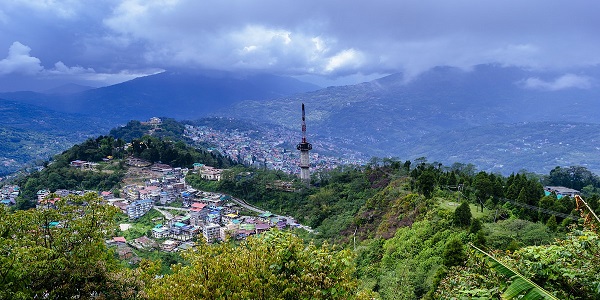 The heart throbbing city, Gangtok[/caption]
The heart throbbing city, Gangtok[/caption]A charming, enjoyably boisterous and covered with clouds - Gangtok, can likewise give you a wide majestic view of Mt. Kanchenjunga, at a far off horizon. The immaculate slope station settled in mountains and mists encourages trekkers towards the Himalayan mountain ranges. The magnificent view and the excellent winding slope streets are much all the more amazing if seen from a Rope way.
Place To Visit In Gangtok
Gangtok Rope-way:
- While you are at Gangtok you should visit rope ways located at Deorali market.
- This place can be easily come to, by taking a nearby taxi from any inn.
- This Rope way is around 1 km long has three stops.
- The minimum point is at Deorali market and the maximum point is at Tashiling ( underneath the state secretariat ).
- There is a mid point stop at Nam-Nang. One can enter from any point and come back to same point, that includes touching other 2 points. Rope-way gives fantastic view of Gangtok market, valley and assembly hall of Sikkim on its 15 to 20 minutes travel.
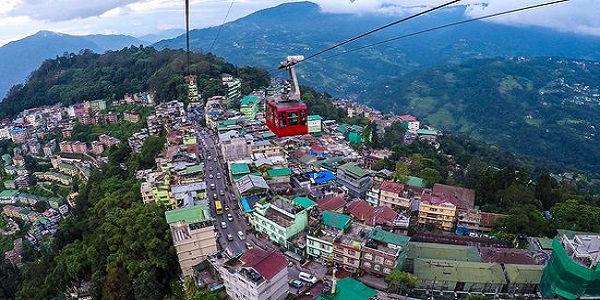 Look from and bird's eye.[/caption]
Look from and bird's eye.[/caption]Tashi View Point:
- This sweltering viewpoint does not have a match because of its unpolluted surroundings which has been created in a way that enables the sightseers to comprehend the stupor of the Himalayas.
- The pleasant atmosphere of the Tashi viewpoint and the picturesque views adding to the serenity makes it an amazing vie point for the tourist to look at the Phodong Monastery and Labrang Monastery from here.
- This place is no less than a heaven for all the nearby localities and in addition youngsters who gather here amid the ends of the week to appreciate and be a piece of the mind blowing tourist place.
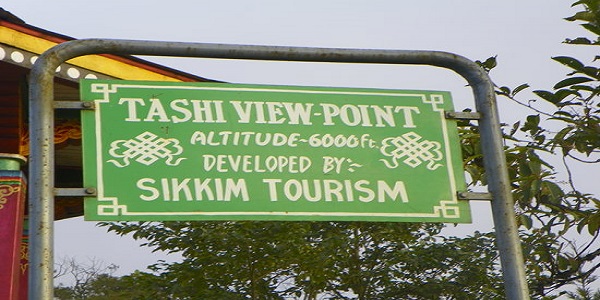 Sikkim tourism boards.[/caption]
Sikkim tourism boards.[/caption]Nathu-La Pass:
- Nathula, also known as the china border is one of the highest driving points in the world, that co joins Sikkim and China.
- Nathula Pass is arranged on the Indo-Chinese outskirt and is one of the most famous destinations in India.
- Many visitors run here consistently to trek in the valley and getting a charge out of the grand excellence.
- There are various brooklets or waterfalls that rush en route from Gangtok to Nathula.
- It likewise offers a chance to see lovely snow crests surrounding the region.
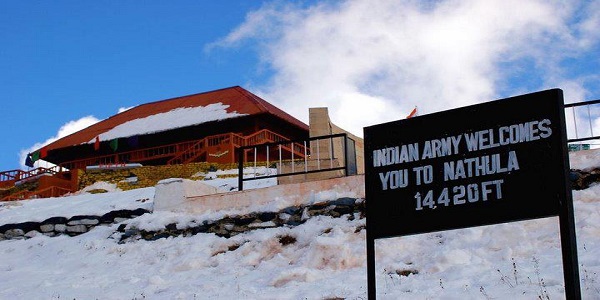 One of the highest passes.[/caption]
One of the highest passes.[/caption]Harbhajan Baba Mandir:
- Arranged out and about going amongst Nathula and Jelepla Pass, at a separation of 64 km at a rise of 4000 meters, Baba Mandir is the place of worship which was worked over the Samadhi of Baba Harbhajan Singh.
- History speaks that, while driving a pack of donkeys from his division at Tukla to Deng Dhukla in East Sikkim, Sepoy Harbhajan Singh disappeared.
- After a hunt his body was found after following three days, by the soldiers.
- It believed that he was one who drove the soldiers to his body.
- Thereby, numerous officers in the troop claim that Baba had been coming in their dreams requesting that they assemble a Mandir in his memory.
- A samadhi was hence made in his memory and called the 'Baba Harbhajan Singh Memorial Temple'. Many believe that Baba visits the temple every night and does his duty rounds, wearing his uniform.
- Individuals love him as a brave soldier and a holy spirit who protects the lives of fighters along the fringe.
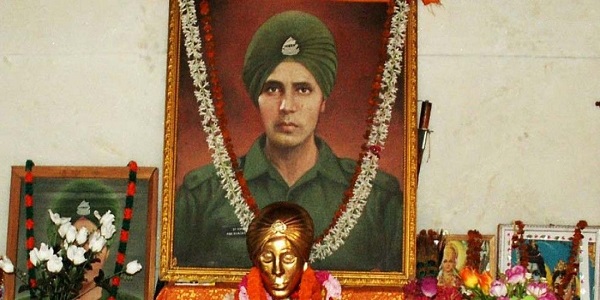 The mysterious patriot.[/caption]
The mysterious patriot.[/caption]Tsomgo Lake:
- Roosted between the mountains at a impressive height of 12400 ft above sea level, the Tsomgo Lake is one of only a handful couple of high-height lakes in India arranged on the Gangtok-Nathula highway.
- This lake is a piece of each traveler's list and for a justifiable reason-its mind-boggling.
- Tsongmo Lake is a frigid lake that gets its water from the melting snows of the mountains around it.
- This frosty lake is appreciated for its changing shades every season.
- Rainy season witness a brilliant sea green/blue lake while, in the winters, the lake solidifies into a translucent front of ice.
- As the late spring approaches in mid-May, the fringe of this lake is specked with a thousand blooming flowers that decorate the periphery with vibrant colors.
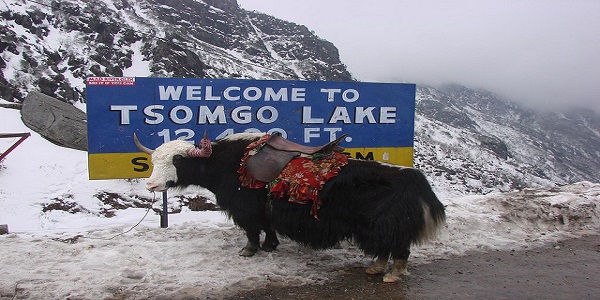 The Yak waits on at the Tsomgo Lake, North Sikkim, India[/caption]
The Yak waits on at the Tsomgo Lake, North Sikkim, India[/caption]Ganesh Tok:
- Ganesh Tok is an adored traveler spot in Gangtok and a small temple devoted to worship Lord Ganesha.
- It is arranged over a slope along that helps visitors have an amazing scenic view.
- The Kanchenjunga slope can be viewed in real greatness from here especially when the sun rises.
- The viewpoint is arranged at a rise of 6500 m offering the astonishing views of the mountains canvassed in snow.
- The temple is anyway so little that it can just fit one individual at once.
- The place makes you a stride nearer to nature with its strange environment and soothing atmosphere.
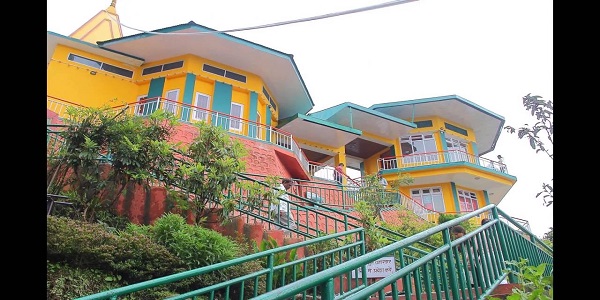 Enshrine for Ganesha's devotees.[/caption]
Enshrine for Ganesha's devotees.[/caption]Hanuman Tok:
- Arranged at the tallness of 7,200 feet the lofty temple is located against the Kanchenjunga which is the third most highest peak in the world.
- It is claimed in the history that Hanuman tok is the place where Hanuman ji rested for a while on his way to Lanka carrying the Sanjeevani parbat.
- Earlier Individuals used to worship a stone that was available here, in the open, until Appaji Pant ( An officer) constructed a statue of Lord Hanuman in the 1950s..
- It is believed that all desires get satisfied here, which attracts attention of local people and additionally travelers from everywhere throughout the nation. In 1968, this zone was given to the Indian armed force, and from that point forward it is kept up and in addition protected by the armed force.
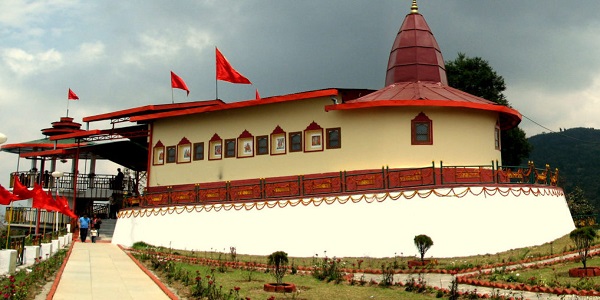 Hanuman tok[/caption]
Hanuman tok[/caption]And many more famous places like: Namgyal institute of Tibetology, Banjhakri Falls, Burtuk water fall, Ranka, Rumtek Monestery, Enchey Monastery, Handloom & Handicraft Centre, Do-drul-Chorten, Nam Nang, Orchid Sanctuary, Deer Park, Himalayan zoological Park, Sa-Ngor-chotshog center, Pal Zurmang Kagyud Monastery, Phodong.
Weather in Gangtok:
Winters- (December to February)
This season outrageous in Gangtok and it can be exceptionally cool out there especially at a young hour in the mornings and at evenings. The normal temperature floats around 4°C. Though snowfall in Gangtok town isn't casual, the places at more elevation from Gangtok like Tsomgo lake and Nathula Pass generally shut their roads due to the snow blankets. Another issue amid winter (especially in February) is the haze. You will frequently discover white covers of fog obstructing the sight scenes.Monsoon (July - September)
You may see constant downpours or shady sky. This is the time when landslides normally occur. Anyway the whole territory ends up rich green and looks at peace without sightseers. The long stretch of July observes heaviest downpours. A portion of the best festive celebrations occur in this season. Most sightseers don't generally visit Gangtok amid winter and rainy season. Since the request falls, the lodging and visit rates likewise get cut amid theseperiods.Summer (May-June)
Summer season, the climate is generally warm. This is the point at which the traveler season is at the pinnacle on account of the late spring, so it can get somewhat swarmed. This is likewise a decent time on the off chance that you wish to explore North and West parts of Sikkim which are moderately colder and can be gone by for just constrained a very long time in summer.Spring (March-April)
It is spring time in Gangtok and most likely extraordinary compared to other time to visit. The climate is icy yet the skies are clear, giving you an all encompassing view of the mountain ranges. This is likewise the best time frame to enjoy the experience exercises.How to reach:
By Air:
Bagdogra is the closest Gangtok Airport at 125 km. You can book a taxi ahead of time to take you up to Gangtok. Helicopter administrations are likewise accessible from Bagdogra to Gangtok. It takes around 4 hours by a navigate to achieve Gangtok from Bagdogra airplane terminal.By Road:
Cabs are accessible from the majority of the urban communities adjacent. Transports from Siliguri are likewise visitBy Train:
Around 117 km from Gangtok resides its nearest railway station named as Jalpaiguri in Siliguri.. New Jalpaiguri is very much associated with significant urban communities in India. It takes around 4 hours to achieve Gangtok from New Jalpaiguri station.Culture & Food.
Gangtok portrays diverse ethnic gatherings of individuals who make their home in this city. Music is a much-adored type of amusement in the city. Western music, Hindi rock melodies and Nepali rock music are extremely well known in Gangtok. Brilliantly costumed traditional dance, called 'chhaams', are organised during festivals. Football, cricket and bows and arrows are the favored games in Gangtok. Sikkimese food is served in a large portion in the cuisine, offering tourists a large number of unique flavors.[caption id="attachment_3404" align="aligncenter" width="600"]
 Mouthwatering food in Gangtok[/caption]
Mouthwatering food in Gangtok[/caption]Momos (steamed dumplings), thukpa (noodles in soup), chowmein (noodles) and shah paley (Sikkimese patti enclosed by batter) are a couple of the mouth-watering claims to fame of Gangtok.
Source: Inditrip


Comments
Post a Comment